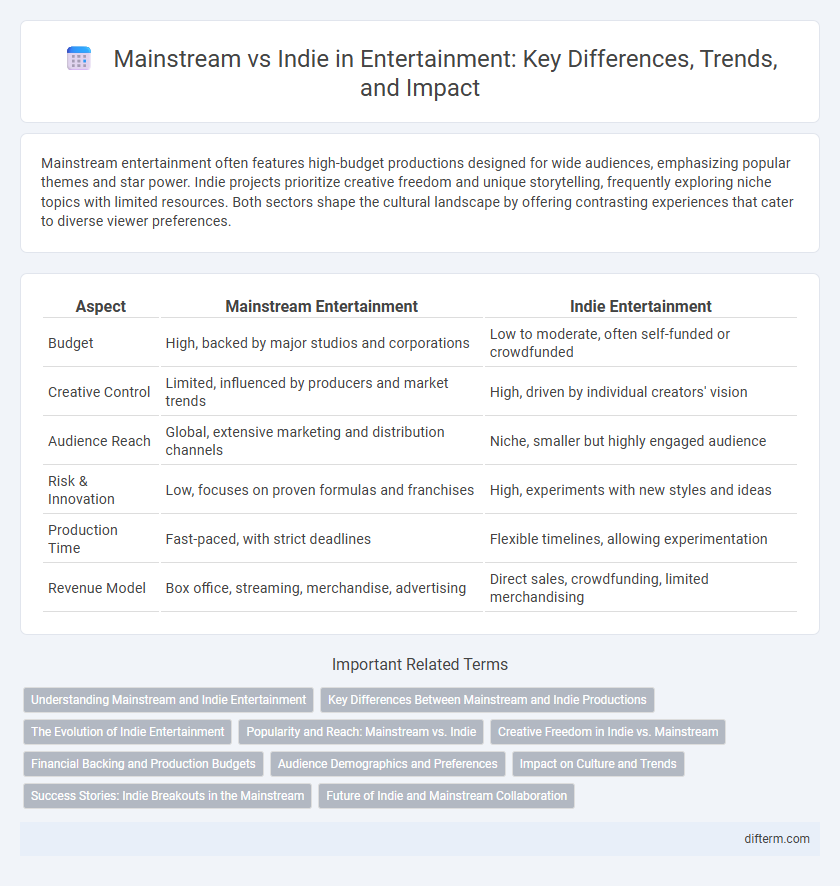Mainstream entertainment often features high-budget productions designed for wide audiences, emphasizing popular themes and star power. Indie projects prioritize creative freedom and unique storytelling, frequently exploring niche topics with limited resources. Both sectors shape the cultural landscape by offering contrasting experiences that cater to diverse viewer preferences.
Table of Comparison
| Aspect | Mainstream Entertainment | Indie Entertainment |
|---|---|---|
| Budget | High, backed by major studios and corporations | Low to moderate, often self-funded or crowdfunded |
| Creative Control | Limited, influenced by producers and market trends | High, driven by individual creators' vision |
| Audience Reach | Global, extensive marketing and distribution channels | Niche, smaller but highly engaged audience |
| Risk & Innovation | Low, focuses on proven formulas and franchises | High, experiments with new styles and ideas |
| Production Time | Fast-paced, with strict deadlines | Flexible timelines, allowing experimentation |
| Revenue Model | Box office, streaming, merchandise, advertising | Direct sales, crowdfunding, limited merchandising |
Understanding Mainstream and Indie Entertainment
Mainstream entertainment dominates global markets with high-budget productions, widespread distribution, and mass audience appeal, often shaping popular culture through films, music, and video games. Indie entertainment, characterized by smaller budgets, creative freedom, and niche audiences, offers unique, innovative content that challenges mainstream conventions and fosters diverse storytelling. Understanding the distinction between mainstream and indie entertainment highlights the balance between commercial success and artistic expression in the evolving media landscape.
Key Differences Between Mainstream and Indie Productions
Mainstream productions typically feature higher budgets, widespread distribution, and involve large studios or well-known production companies, ensuring extensive marketing and commercial appeal. Indie productions are characterized by smaller budgets, independent financing, and creative freedom, often resulting in unique storytelling and niche audience targeting. These differences influence the scale, style, and market reach of films, reflecting distinct priorities in artistic expression versus commercial viability.
The Evolution of Indie Entertainment
Indie entertainment has evolved from niche underground productions to a formidable presence rivaling mainstream media in storytelling innovation and audience engagement. Digital platforms and crowdfunding have democratized content creation, enabling independent filmmakers, musicians, and game developers to reach global audiences without traditional industry gatekeepers. This shift challenges mainstream dominance by prioritizing authentic voices, diverse narratives, and experimental formats that resonate with contemporary consumers seeking unique cultural experiences.
Popularity and Reach: Mainstream vs. Indie
Mainstream entertainment dominates global markets with widespread distribution channels and large marketing budgets, resulting in extensive popularity and mass audience reach. Indie productions often rely on niche platforms and grassroots campaigns, attracting dedicated but smaller, more targeted fanbases. The contrast in popularity and reach stems from budget disparities and promotional resources, shaping distinct audience engagement patterns.
Creative Freedom in Indie vs. Mainstream
Indie entertainment offers significantly greater creative freedom compared to mainstream productions, allowing creators to explore unique narratives and unconventional styles without commercial pressures. Mainstream projects often prioritize mass appeal and profitability, which can constrain artistic expression and limit innovative storytelling. This freedom in indie work fosters originality and diverse voices, contributing to a richer and more varied entertainment landscape.
Financial Backing and Production Budgets
Mainstream entertainment productions benefit from substantial financial backing, often sourced from major studios, enabling high production budgets that support advanced special effects, star talent, and extensive marketing campaigns. In contrast, indie films operate with limited budgets, relying on independent investors or crowdfunding, which often results in more creative freedom but constraints on scale and distribution. These budget disparities directly influence the scope, quality, and audience reach of mainstream versus indie projects in the entertainment industry.
Audience Demographics and Preferences
Mainstream entertainment typically attracts a broad audience demographic, including diverse age groups and mainstream cultural preferences, favoring familiar themes and high-budget productions. Indie entertainment appeals to niche audiences who seek unique, experimental, or culturally specific content, often valuing artistic expression and authenticity over commercial appeal. Audience preferences in mainstream genres tend to prioritize accessibility and entertainment value, while indie audiences prioritize innovation, storytelling depth, and unconventional narratives.
Impact on Culture and Trends
Mainstream entertainment dominates global culture by setting widespread trends through high-budget productions and mass distribution channels, influencing fashion, language, and social norms. Indie entertainment fosters cultural diversity by promoting unique, experimental narratives that challenge traditional perspectives and inspire niche communities. Both sectors drive innovation and cultural evolution, with mainstream shaping mass appeal and indie nurturing creative authenticity.
Success Stories: Indie Breakouts in the Mainstream
Indie films like "Moonlight" and "Lady Bird" achieved critical acclaim and box office success, redefining mainstream cinematic narratives with unique storytelling and diverse perspectives. Independent musicians such as Billie Eilish transitioned from bedroom studios to global arenas, signaling a shift in the music industry's embrace of authentic, grassroots talent. These success stories illustrate how indie creators leverage digital platforms and niche audiences to penetrate mainstream markets, challenging traditional entertainment power structures.
Future of Indie and Mainstream Collaboration
The future of entertainment is marked by increasing collaboration between mainstream studios and indie creators, blending big-budget resources with unique, innovative storytelling. Indie filmmakers bring fresh perspectives and niche audiences, while mainstream platforms provide wider distribution and marketing power. This synergy drives diverse content production, expanding market reach and enriching viewer experiences.
mainstream vs indie Infographic

 difterm.com
difterm.com